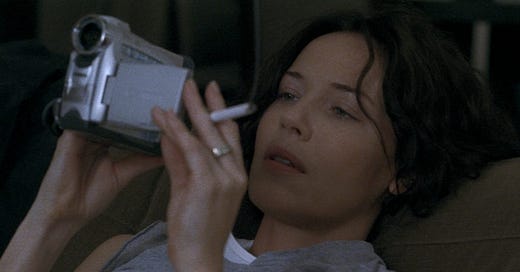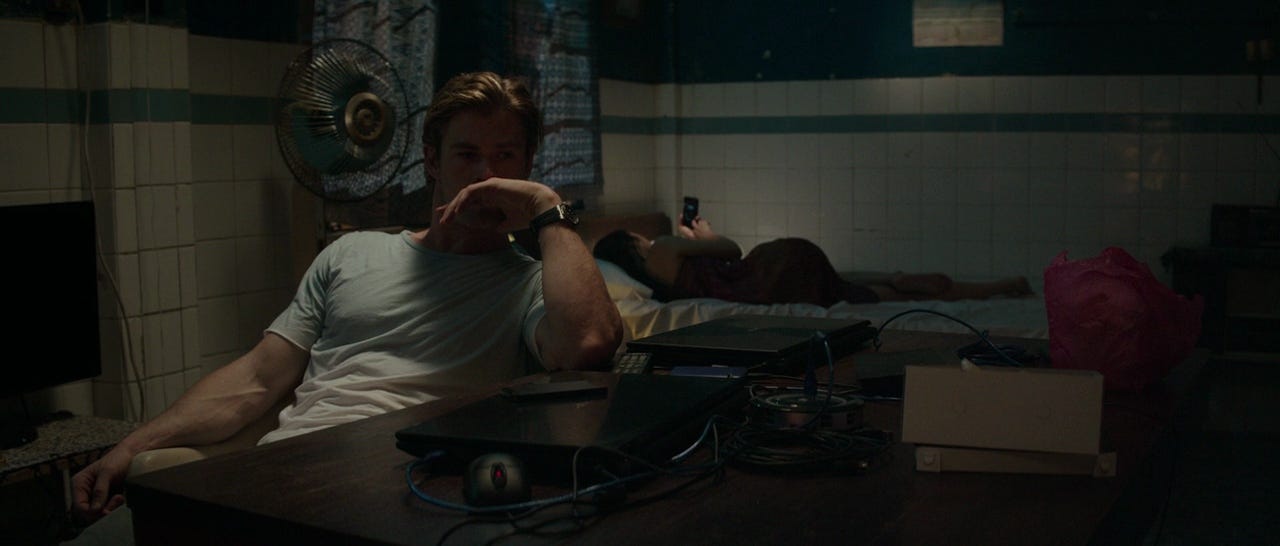Greetings from Read Max HQ! In today’s newsletter, a new coinage-slash-microgenre: arty thrillers about globalization, which I’m going to call “S.E.Z. Noir”
A reminder that this newsletter publishes at the pleasure of its paying subscribers, whose generous contributions allow me to treat it as a full-time job--reading, reporting, thinking, writing, and doing all the other things that mean you get at least one single relatively pleasurable email in your inbox every week. If you appreciate Read Max--if it is, in fact, the one guaranteed pleasurably email in your inbox every week--please consider subscribing for the low price of $5/month or $50/year. Imagine it like buying me one cold beer every month, even though I will use at least some of the money for non-beer expenses.
Since watching the forgotten 2003 sci-fi romance Code 46 a few weeks ago, an unfortunate urge has been impressing itself upon my brain: The urge to coin a microgenre. Code 46, a Michael Winterbottom movie about an insurance investigator (played by Tim Robbins) sent to near-future Shanghai to investigate a passport forger, is not a categorically great film, but it’s a prime example of a particular type of film that brings me a lot of pleasure--what might be simply described as “arty thrillers about globalization,” but which I’m going to call, for the purposes of creating and protecting my own intellectual property, S.E.Z. Noir.
In the movies I’m thinking of--some non-specific spoilers follow--the main characters are usually relatively marginal, grey-market players in the vast systems that move money and goods across borders: an insurance investigator for a multinational corporation, as in Code 46; or an ambiguous partner in a European-Asian import-export businesses, as in Boarding Gate; or a hacker ex-con conditionally freed thanks to an international law-enforcement partnership, as in Blackhat. They’re operators and maneuverers trying to carve out freedom and security for themselves, but whose schemes take a wrong turn--or who find themselves out-schemed by a partner or rival. They go on the run, most often through the malls and markets and alleyways of an Asian city--whether Tokyo (New Rose Hotel), Shanghai (Code 46), Hong Kong (Boarding Gate) or Jakarta (Blackhat)--which is understood and positioned as a kind of futurological frontier. (The “S.E.Z.” of S.E.Z. Noir comes from the Special Economic Zones that have defined the terrain of globalization in the 21st century.)
Pursed by government agencies, criminal syndicates, or corporate interests--though in these movies the boundaries between those three groups is never clear--our characters most often end up dropping off (or being forced from) the grid entirely, not necessarily as free people but as stateless, paperless ghosts, drifting ambivalently through globalization’s wreckage.
This is not a capacious category of movie. To the artier, French-er side of Code 46 we have Olivier Assayas’ Demonlover, a corporate thriller about bidding war over a hentai company, and Boarding Gate, which features Kim Gordon as a Cantonese-speaking gangster. To the thriller-ier, Hollywood-er side you have Michael Mann’s beloved mega-bomb Blackhat (and, arguably, Christopher Nolan’s Tenet). If you reach back into the 1990s you can pull out Abel Ferrara’s William Gibson adaptation New Rose Hotel (S.E.Z. Noir in general shares a vibe with Gibson’s Blue Ant trilogy), and if you allow quasi-comedies, the criminally under-seen Ghostbox Cowboy is an obvious contender. Depending on how important you think the East Asian urban futurism aspect is to the genre, you might also include Jim Jarmusch’s opaque The Limits of Control, about a border-crossing European hitman; Tom Tykwer’s bleak-as-hell international corporate-crime thriller The International; and Ridley Scott’s grim cartel drama The Counselor.1
But without wanting to wholly exclude those last three nominations, I tend to think that a particular fascination with East Asia, and a sense of cities like Shanghai and Jakarta as a glimpse of, or even the site of, the future is an important component of the genre I’m trying to outline.2 In some ways I think of S.E.Z. Noir as one successor genre to Nokiawave, a name coined by the designer David Rudnick to describe a particular breed of 1990s techno-thriller where everyone wore long leather blazers, shouted about “the uplink,” and ran around a post-Soviet Eastern Europe depicted “as one enormous physical black market.” (Think Goldeneye, The Saint, The Jackal, etc.) Where Nokiawave transmuted its era’s geopolitical anxieties about the end of the Cold War into (frankly pretty sick) action movies, S.E.Z. Noir transmutes a newly rising set of geopolitical concerns of its era--globalization, deindustrialization, and what was not yet known as “the China Shock”--into diffuse, vibe-y international thrillers.
In this sense the more “difficult,” arty sensibility of S.E.Z. Noir isn’t an accident. The Hollywood blockbuster moved pretty seamlessly from the post-Soviet world of Nokiawave into spec-ops War-on-Terror morality plays like the Bourne series, leaving what were at the time seemingly background concerns like “logistics” and “international supply chains” for pretentious European directors like Assayas and Winterbottom to mine for thriller subjects. And consequently, S.E.Z. Noir tends to be elliptical, disjointed, "art-house," its narrative opacity a kind of mirror of the incomprehensibility of the totality of the global economy. Its look is defined by handheld, always-in-motion cameras shooting on location in what the pretentious among us used to call “liminal spaces” (alleyways, loading docks, airports, border crossings). The often barely sketched genre plots of S.E.Z. Noir I’ve outlined above are generally used as a kind of skeleton onto which these thematic concerns are grafted: Globalization, supply chains, capital flows, logistics, marketization, surplus populations, and, as we’ve been saying, an obsessive if ambivalent Asian futurism. Stephen Shaviro’s writing on Boarding Gate gets at some of the other visual markers of the genre and how they relate to its ideas:
Assayas gives us a sensuous, almost tactile, sense of this world of total abstraction and ubiquitous commodification. Everything is shot in what J. Hoberman, who doesn’t get the film as all, calls a “jagged yet posh faux-vérité style” (this is an accurate description, as far as it goes, but needs to be understood more positively than Hoberman intended). The film is set in Paris and Hong Kong (and in airplanes flying from one city to the other, and cabs and limos moving down the streets and highways of both cities). It is spoken mostly in English, but with scenes and conversations in French and in Cantonese (untranslated by subtitles, at least in the print I saw) as well. It moves between luxurious condos and busy shipyards, between expensive nightclubs and crowded streets, between airplane latrines and rooms filled with computing equipment. The camera floats hypnotically through these spaces, which always seem tangibly luscious, and yet oddly distanced at the same time. It’s like being at an extremely upscale mall, where everything is beautifully arranged, and almost crying out for sensuous contact and absorption — but at the same time, it is basically a spectacular display, rather than something you can actually use or interact with. There are few still shots; the camera is always moving, zooming in, or panning laterally, horizontally. Sometimes the camera circles back on itself, or restlessly turns left and right. Nearly everything appears in shallow focus; and rack focus shifts are frequent (often used for dialogue instead of shot/reverse shot). There are always blurry planes before or behind whatever layer the camera is focused clearly upon. Everything seems to come in layers: glass, machinery, moving crowds. We see layers through the blurs or transparency of other layers. Everything is immaculate: even blood pooling on the floor after a murder, even the toilets in which the protagonist pukes after witnessing (or actively participating in) such violence. The decor, and the camerawork that presents it to us, are not exactly numbing, even if they are distanced: there is always a sense of cold fever, of icy delirium — epitomized by, but not restricted to, the ritzy Hong Kong nightclub with dazzling disco lights, where somebody is equally likely to thrust a karaoke microphone upon you or to spike your drink.
I suspect there are a number of recent Chinese films that these movies could be programmed alongside--Jia Zhangke’s crime movies, maybe, or Diao Yinan’s two excellent modern-China noirs--even if they emerge from a somewhat shifted bundle of anxieties and concerns. But in general I think of S.E.Z. Noir as a Western genre, because so much of it is about Americans and Europeans coming to terms with globalization: Not just on a thematic level, but in the narrative sense that so many of these movies are about westerners realizing that they are not as essential, powerful, or quick-witted as they imagine themselves to be, and finding themselves swept away by flows of capital and trade to which they are only really accessories.
It’s for this reason, I think, that even as logistics and supply chains and the dynamics of globalization become more widely covered and emphasized in the press, S.E.Z. Noir is effectively "over." The accession of Trump, the spread of COVID, the declaration of trade wars, and China's full assumption of economic power have made it excessively clear to all of us what the heroes of S.E.Z. Noirs learned early.
I haven’t seen it yet, but I am also intrigued by the 2009 Tran Anh Hung movie I Come with the Rain, starring Josh Hartnett, which was nominated and recommended to me on Bluesky. Among other things I’m surprised that this isn’t available on streaming given the mini career renaissances of both Hartnett and Hung. Mubi, Criterion, WYA?
Arguably The Counselor subtly shares this Asian futurism: In its final scene, the surviving character announces a move to Hong Kong.









I wish mark fisher could have read this
This is a really interesting post that made me think of ... Don DeLillo. His 1982 novel The Names has most (if not all) of the thematic elements you identify, except that America is the advanced techno-authoritarian presence and Greece is the resistant society. I normally feel squeamish about calling artworks 'prescient', but it's all in there. The microgenre is nearly 50 years old.